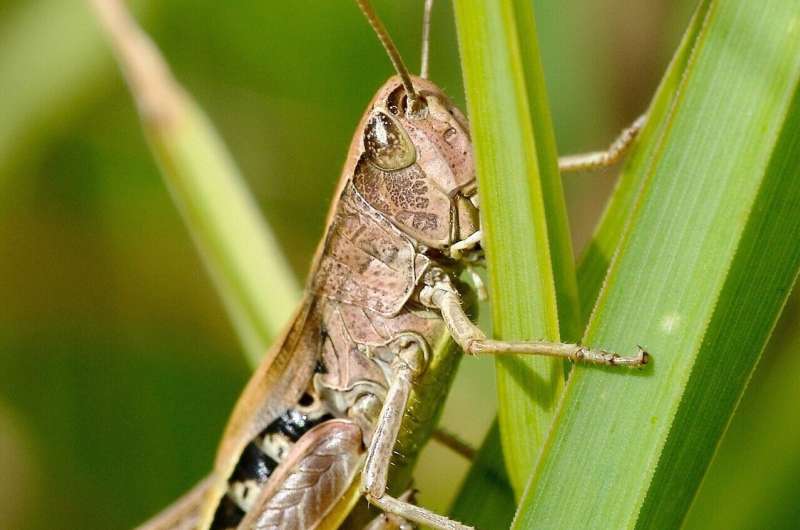This article has been reviewed according to Science X's editorial process and policies. Editors have highlighted the following attributes while ensuring the content's credibility:
fact-checked
proofread
Mass breeding of desert locusts unlocks new food source

Mass breeding of desert locusts in a controlled environment could provide a sustainable source of protein for animals and humans as well as business opportunities in Sub-Saharan Africa, researchers say.
With nearly 282 million people in Africa undernourished and a growing population, there is an urgent need for more sustainable food sources, and edible insects have attracted much attention as one part of the solution.
In 2022, researchers at Makerere University in Uganda and Egerton University in Kenya, developed a field-scale prototype for producing large numbers of desert locusts in giant greenhouses in Homa Bay County, Kenya.
Rich in protein, locusts can be used to feed animals including poultry, pigs and fish, and are safe for humans to eat, provided they are not contaminated with insecticide.
"The idea of mass rearing of desert locusts was conceived to address the perennial shortage of quality animal feeds and also be a rich source of proteins for locust-based human foods," said Joshua Ogendo, principal investigator for the Locust4Industry project and associate professor of crop protection and principal of Egerton University, Kenya.
The researchers say the mass breeding method, which followed a lab-scale protocol developed by the International Center of Insect Physiology and Ecology (Icipe), is now ready to be piloted.
The innovative approach uses what the researchers call Roof-Park Greenhouse Technology (RPGT)—a dome-shaped greenhouse—to create a controlled environment with optimal temperature and humidity.
The locusts are contained in a system of cages protected by wire gauze to stop them from escaping, allowing them to be bred on a large scale.
Desert locusts are usually fed natural food crop diets such as wheat seedlings or common beans. However, scientists are trying to formulate non-food crop plant diets in order to ensure a sustainable food supply.
Phases one and two of the prototyping and development of the facility were supported by the Science Granting Councils Initiative (SGCI), which seeks to strengthen the capacities of public science funding agencies in Sub-Saharan Africa.
Economic boost
Ogendo and his team say the Locust4Industry project will enable industrial exploitation of the desert locust as a nutritional food source.
"The field-scale mass-rearing of the desert locust is anchored on a unique model that allows for cascading the technology to local communities, small and medium enterprises, and food and feed industrial players," he explained.
According to Ogendo, the involvement of local communities in the initiative could help spur economic empowerment, job creation, and improved livelihoods.
Chrysantus Mbi Tanga, head of the Insects for Food, Feed and other Uses program at Icipe, says desert locusts are an excellent alternative way to meet the need for proteins and enhance food security in the region.
The protein, fat and energy content of locusts are equal to or higher than that of meat, according to various studies.
"Desert locust is not only a source of protein but also contains various nutrients, vitamins and minerals such as iron, zinc, and calcium," Tanga explained.
He said scaling the mass breeding approach for locusts could provide viable business opportunities in Sub-Saharan Africa.
However, he stressed that greenhouse mass rearing should be done with caution.
"Escape [of locusts from the greenhouse] can lead to significant crop loss that might exacerbate problems of food shortage, threatening food security in the region," he warned.
Silvenus Konyole, associate professor of food science and nutrition at Masinde Muliro University of Science and Technology, Kenya, says the new technology will go a long way to reducing the cost of animal feeds which are mainly expensive due to the protein component.
He noted that there are currently standards already developed by the Kenya Bureau of Standards for insects as food and feed.
"If these are adhered to, then the safety aspect will be addressed," Konyole said.
Provided by SciDev.Net




















